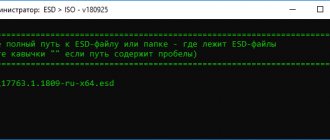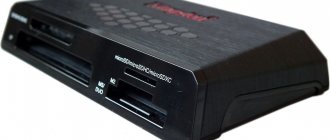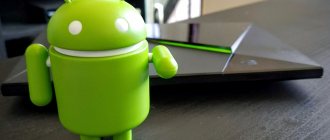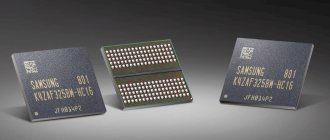Computers... These “creatures” appeared on our planet relatively recently, and for many years they have been gathering thousands of people around them, attracting them with their capabilities. Some people play computer games, others write articles on them, and sometimes they can serve as your second TV or information storage device. While using your computer, have you ever asked yourself, “How the hell does this work?” If they asked, they probably didn’t answer it, going online and wasting hours of their time. Actually, that's what I'm here for. I'll tell you briefly what exactly is in your computer and how it works.
How it works?
Most sound cards use a DAC (Digital to Analog Converter) to convert digital audio signals to analog. The signal is output to conventional headphones and other acoustic devices. More advanced cards may include more than one sound chip to support high data rates and perform multiple simultaneous functions.
Connection nuances
External audio adapters are connected via a USB connector, which is found in any PC or laptop.
or ExpressCard port.
Therefore, before purchasing, decide where you will connect the video card in your laptop (the ExpressCard port is only available on laptops).
The connection process itself is not complicated, but questions may arise with activation. The fact is that when a device is connected, the system does not always recognize it properly, or the external one may conflict with the built-in one.
To the computer
Let's consider the procedure for connecting an audio card to a computer:
- Before connecting an external sound card, read the instructions. Some manufacturers write that you first need to connect the adapter and then install the drivers. Others indicate actions in the reverse order.
- After you have connected the card and installed the drivers, check if they are installed correctly:
- go to “Device Manager” (“Start” - “Control Panel” or “Computer” (right mouse button) - “Properties”);
- on the “Sound and video devices” tab, find your card and make sure that there are no warnings on it in the form of question marks or exclamation marks; the same applies to USB controllers.
- If everything is in order, you can close “Device Manager” and go to “Playback devices”:
- right-click on the speaker icon on the taskbar and select the desired item;
- on the “Playback” and “Record” tabs the installed card should be displayed and have confirmation of readiness for use;
- In order for an external audio card to always be used, you need to assign it by default by right-clicking on its name, and disable the integrated one in the same way.
- Now check if the adapter works - connect headphones to it and try to listen to the track. There are situations when a new card does not connect to the host automatically, then this must be done manually:
- launch Audition and on the “Options” tab select the “Device Order” menu;
- the name of the connected USB card should be on the left side of the window, where all active devices are visible; If it is displayed on the right, select it and click on “Use”;
- move the name of the card to the beginning of the list so that it works both in the multitrack and in the audio editor - select the card and click the “Up” button at the bottom of the window and then “use in the wave editor.”
Now you can start setting up your microphone.
- If your device has phantom power, you need to turn it on.
- Connect a microphone to the input. If there are two of them, go to the first one, and assign it to track recording: switch Audition to multi-track mode and press the “Input 1” button on the first track. Next in the window that opens is about (it is set automatically for the first microphone input) and “So for all tracks.”
- Save the settings by clicking “Ok” and check the microphone’s operation: click on the red “R” button on the first track and twice in the recording indicator field. Say something and watch the indicator react. If it is, everything is configured correctly.
You can also use these instructions to connect an external sound adapter to your laptop.
To a tablet or smartphone
If you want to get high-quality music sound from your device to Android, you can connect a USB sound card using an OTG cable as an adapter:
Connect the micro-USB to the connector of your tablet or smartphone, and on the other side, insert the USB output from the card cable and try to start the audio player. If there is no sound, reboot the device. In some cases, built-in audio players do not work with this system - download and install the program Usb Audio Player Pro, neutron or Poweramp.
Where is the sound card?
Regardless of the fact that a computer does not require a sound device to function, sound cards are included for the convenience of the user in most, either in an expansion slot, integrated into the motherboard, or connected through external ports.
Integrating a sound card into the motherboard allows for cheaper assemblies compared to an expansion card and with an imperceptible loss of sound quality for the average user. Separate sound cards, as practice shows, are only necessary for a serious audio professional or for use when the integrated one fails.
The sound card is installed into slots on a modern PCI or PCIe motherboard. A typical card has an interface that can be accessed on the rear panel with various audio output and input ports, and depending on the design of the computer case, audio input and output ports located on the sides of the case or even at the top.
For computers, the upgrade of which usually involves increasing the amount of RAM or replacing the hard drive with a solid-state drive (laptops, all-in-one PCs, nettops), it is possible to use an external sound device that performs the function of a sound card, usually connected to the computer via USB ports.
Types of cards
There are two types of audio cards - integrated and discrete. External ones are connected via FileWire or USB. Internal when assembling a computer by attaching expansion slots inside the system unit.
The main disadvantage of embedded devices is the huge risk of poor-quality PC power supply, that is, power surges and failure of the power supply. External ones are more practical, which is explained by external volume controls. Moreover, a unit of this type can work with both a laptop computer and a laptop or netbook.
In the case of an integrated card, its functions are performed by a processor that processes signals and converts sound. The discrete card has a personal sound processor, and some models even have their own memory.
So why do you need an external sound card if you have a built-in one? It's simple, with its help you can achieve the highest quality and clearest sound, as well as gain access to a number of important settings.
Drivers and software
Typically, the sound card or sound chip, in the case of integrated audio, comes with proprietary software on disk or can be downloaded from the hardware manufacturer's website. Modern operating systems can easily detect and load drivers for popular sound cards.
Such software can allow the user to make more subtle adjustments and provide recording, editing, etc. tools.
Why do you need a non-integrated audio card?
Devices with advanced functionality for music lovers can be equipped with a midi interface or SPDIF (Sony-Philips Digital Interface), input and output ports, headphone jacks with their own volume controls, the ability to connect to a computer not only via PCI and PCI-e, but also FireWire, USB, etc.
Mixer
Surely, when reading the article, many wondered - what kind of mixing consoles are we talking about, if we talk about them as an addition to the PCI card of a computer?
There are not many requirements for such a device: good characteristics of the audio path (minimum noise and distortion, minimal interpenetration of channels), the inputs/outputs you need and a good headphone amplifier. Most compact analog models from renowned manufacturers fully meet these requirements: Samson (MDR series), Mackie, Yamaha (MG series), Soundcraft (Compact series), Behringer (Xenyx series). The latest brand's products should be considered as a budget option. The average cost of a compact mixing console is $90-200.
Colors of analog 3.5 mm sound card connectors
Most sound cards have ports for connecting speakers, microphones, and auxiliary devices. But there are also cards with more input and output ports designed for more advanced tasks.
Below are the most common audio connectors:
- Pink – microphone audio input;
- Light blue – linear audio input;
- Light green – linear audio output for the main stereo signal (front speakers or headphones);
- Orange – linear audio output for the center channel or subwoofer;
- Black – linear audio output for surround sound, usually the rear speakers;
- Gray – linear audio output for surround sound from side speakers.
There is also an additional gaming port - MIDI -15 pin connector for connecting additional audio devices.
From the history
In the past, computers could produce signals using a narrow range of frequencies as warning signals. With the growth of multimedia comes the need for high quality audio for entertainment and professional reasons.
The Adlib sound card has become a pioneer in these areas. It provided a more natural sound than the Creative Music System released around the same time in 1988.
The introduction of Sound Blaster sound cards by Creative Labs greatly increased their capabilities, allowing digital audio recording and playback. Therefore, Sound Blaster can be called the first sound card that made digital audio possible.
This increase in functionality led to the multimedia evolution of computers and audio-enabled programs created for them. Audio quality continues to evolve in terms of hardware and software.
Modern audio cards can provide higher quality 3D surround sound output. Computer programs and games are developed to take full advantage of their capabilities and satisfy human needs.
Summing up
This article covers the topic of the sound card, and repeatedly points out that the capabilities of the sound card and audio speakers, the entire audio system, affect the overall sound quality.
Many motherboards today have built-in sound cards, they are equipped with special chips, and the ports can be routed anywhere, depending on the design of the device. But you can use third-party sound cards and external audio devices, purchase and install them separately, although the capabilities of the built-in devices will probably be sufficient for people who are not sound fans.
- Forward
Comments
-4 profile 10.30.2018 21:31
Need cheap hosting? Try webhosting1st, just $10 for an year.
Reply Reply with quote Quote
Update list of comments
Add a comment
What is a sound card and what is it for?
What is an SSD? Solid State Drive
What is a processor, central processing unit, CPU?
What is a motherboard or system board and what is it used for?
What is HDD, hard drive and hard drive
What is RAM and Random Access Memory
Sound Features
Dolby Digital and DTS Digital Surround are surround sound standards used in the DVD format. If the PC is equipped with an audio card that supports the same standards, then the sound is reproduced without any distortion or noise, creating the effect of presence.
Today, the standards of audio devices for the highest quality reproduction of music and sounds are incredibly diverse. One of them, EAX and its improved version, EAX ADVANCED HD, guarantee excellent sound quality, which is achieved through the use of modern effects technologies.











